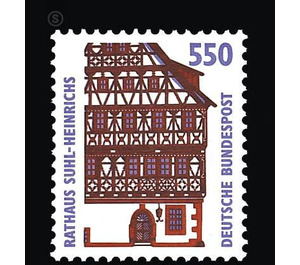Postage stamps: sights - Germany / Federal Republic of Germany 1994 - 550 Pfennig
Theme: Architecture
| Country | Germany / Federal Republic of Germany |
| Issue Date | 1994 |
| Face Value | 550.00 |
| Color | brown white |
| Perforation | K 14 |
| Printing Type | indirect 2-color letterpress |
| Stamp Type | Postage stamp |
| Item Type | Stamp |
| Chronological Issue Number | 1619 |
| Chronological Chapter | GER-BRD |
| Michel ID | BRD 1746 |
| SID | 274654 |
| In 27 Wishlists | |
At the Heinrichs street market, a listed ensemble from the middle of the 17th century, the town hall rises in an impressive size as a dominant building. The patches of Henry (from the "Heinrichs Hof") can be referred to documentary records of 1111 and 1116. Free farmers had founded it, located on the southern slope of the Thuringian Forest. Flourishing trade and change secured the neighbors, as the men entitled to vote called themselves a modest prosperity. As a clear sign of this they established themselves in 1551 a Amtshaus. A court clerk with his 12 councilmen led the regiment alongside the mayors, exercised jurisdiction over the lower courts, and made sure that all assured justice was taken care of. The Thirty Years War left the place untouched. A passing imperial army under General Isolani burned him down in 1634. Only the 1503 consecrated St. Ulrich's Church and rectory remained completely spared by the fire. 1631 lived in the village 200 families, but war and plague ravaged more than half of the inhabitants there. All the more astonishing, then, is that about 20 years later 160 partially rather magnificent half-timbered houses, including the town hall, were newly built. The construction time for this stately building was only two years, the community bills provide detailed information. The surviving sandstone ground floor (13.5 x 16.5 m) was used again, and above it presents the variety of forms Hennebergisch-Franconian timber architecture, always taking into account constructional-technical requirements, the decoration on posts, Rähmhölzern and ceiling joists or caused the filling of the compartments. The balustrade fields of the more than 18 m high gable front give the rhombus, St. Andrew's cross and the figure of the "wild man", decorated with carved hearts, acorns and rosettes, the special character. Double crates with dew ornaments and tooth cut emphasize the building horizontally. The corner posts show round columns and volutes, while a frightful head under the right corner post faithfully guards the house and its inscription. The building was both a meeting place and administrative seat; it also contained a dance floor, defeats for the community fees, two custody rooms and a taproom. The building fabric was considerably affected in 1920 by conversion measures to gain housing; abandoning the original room structure, walls and chimneys were pulled in and dormers were placed. Since 1936 Heinrichs is a district of Suhl. Thus, the house had lost its function as a Amtshaus. After extensive renovation measures from 1980 to 1983, it served essentially cultural purposes. With its historic offices, an exhibition on the history of the city of Suhl and changing special exhibitions, the Henneberg Museum Veßra Monastery has made the house more accessible to the public since 1990. (Text: Roswitha Günther, Hennebergisches Museum Kloster Veßra)
| Condition | Name | In Stock | Price | Price + Shipping | Store | |
|---|---|---|---|---|---|---|
 | Unmounted Mint ** | Postage stamps: sights - Germany / Federal Republic of Germany 1994 - 550 Pfennig | 5 | US $4.31 | US $7.53 |  FILATELIELOKET (0) FILATELIELOKET (0)Shipping US $3.22 |


